|
During the early years of this time period, the American Christmas
lighting industry "found its own" so to speak. The public was now really
beginning to embrace the idea of lighting their trees electrically, and as
many more towns and cities were wired for electricity the variety of
lighting outfits on the market grew dramatically. The advertising efforts
of Morris Propp, the founder of the M. Propp company were instrumental in
bringing the idea of electric Christmas lights to the public's eye during
this time. (See The Morris Propp Story also
on this site.) Store shelves featured a mixture of both the leftover "old
fashioned" carbon lamps and the new tungsten cone bulbs, but tungsten
filament cone shaped lamps were the standard for the high quality sets by
the late 20s. These series wired outfits (when one lamp burns out they all
go out) were soon to be common in American homes.
Safety concerns
brought about the formation of national standards for "decorative"
lighting, which were overseen by the infant Underwriters Laboratories. By
1930, most homes were using the now-standard two bladed wall plugs, making
decorating with electricity all the more convenient. The NOMA Electric
Corporation, which was shortly to become the largest manufacturer of
Christmas lighting in the world, was formed during the late 20s, changing
forever the decorative lighting industry. (More details about the
formation of NOMA can be found at The NOMA Story
section of this site). Below and on the next several pages, you'll
find many examples of lighting outfits from this era, presented in the
approximate order of their appearance on the market.
|
Outfits from the earliest part of this era
can be exceedingly difficult for the collector to date accurately.
The early 1920s were transitional years, and consumers were likely to
see "old fashioned" carbon filament lamps sold alongside the new
tungsten filament ones. All shapes of light bulbs were offered as
well. As we move
toward the latter half of this decade, most sets were offered with the
smooth or textured cone C-6
miniature based lamps exclusively in their outfits. |
|
Date |
Manufacturer |
Notes |
Outside of Box |
Inside of Box |
| ca
1921 |
Rudges |
Here is a most unusual
outfit, consisting of only seven series wired candle shaped
holders and American-made clear glass carbon lamps. Prior to this
discovery, this collector had never seen a seven light series wired
outfit designed for operation on 110-120 volts. The set works
perfectly, and the lamps operate with proper brightness. There have
been no repairs whatsoever to the cord, so the possibility of a
previous owner having removed a defective socket can be eliminated.
The seven section insert is original to the box as well. |
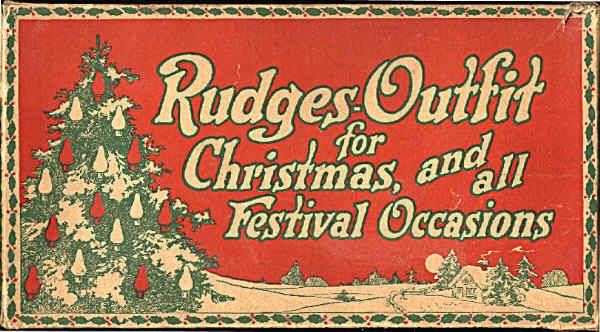 |
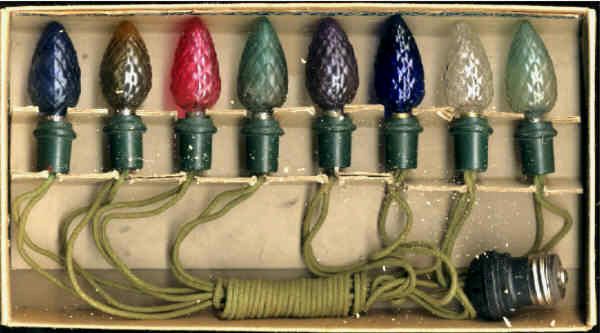 |
| 1921 |
Owl
Flashlight Company |
A very colorful box contains a
typical-for-the-times set of smooth cone miniature base lamps.
However, the inner flap of this outfit contains a wealth of
information useful to the collector. First, it identifies the
Bryant-Owl festoon as original to the box. Secondly, the
nomenclature leads to the assumption that bladed connectors were not
yet used as wall plugs, but only as interconnecting devices for
things like Christmas lights. No mention is made of the Haft patent
which would have covered these lights if made after 1921. Smooth
cone GE MAZDA lamps were introduced in 1919Since the picture of the
lamps on the flap shows smooth cones, this dates the set to the
years 1919-192, a rare opportunity for a collector to pinpoint a set
so closely.1 |
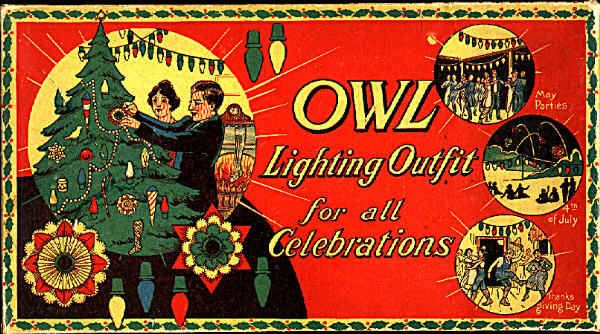 |
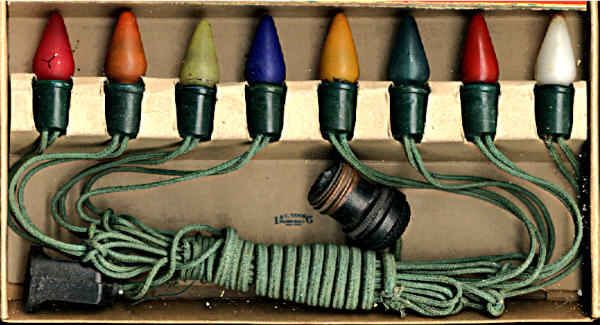 |
| ca
1921 |
USALITE |
Here is an outfit
that is an example of late use of carbon filament lamps. It is
presented in a box similar to the one pictured directly below, but
was marketed under USALite's Bluebird brand name. A close-up of the
box label appears below.
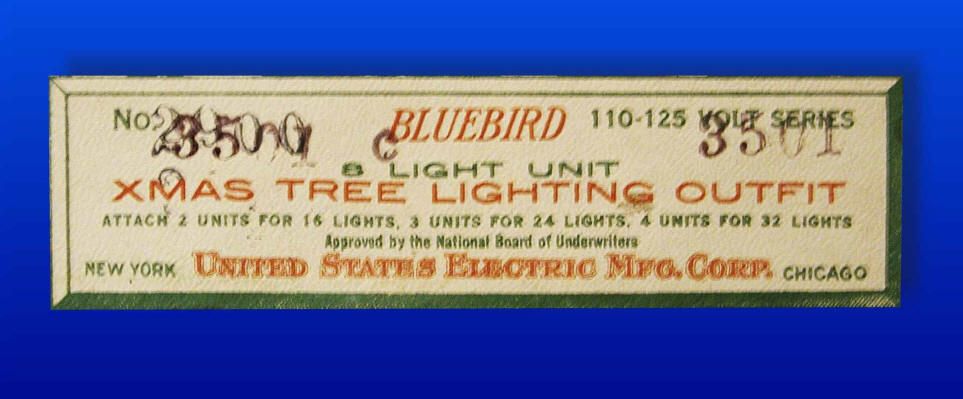
|
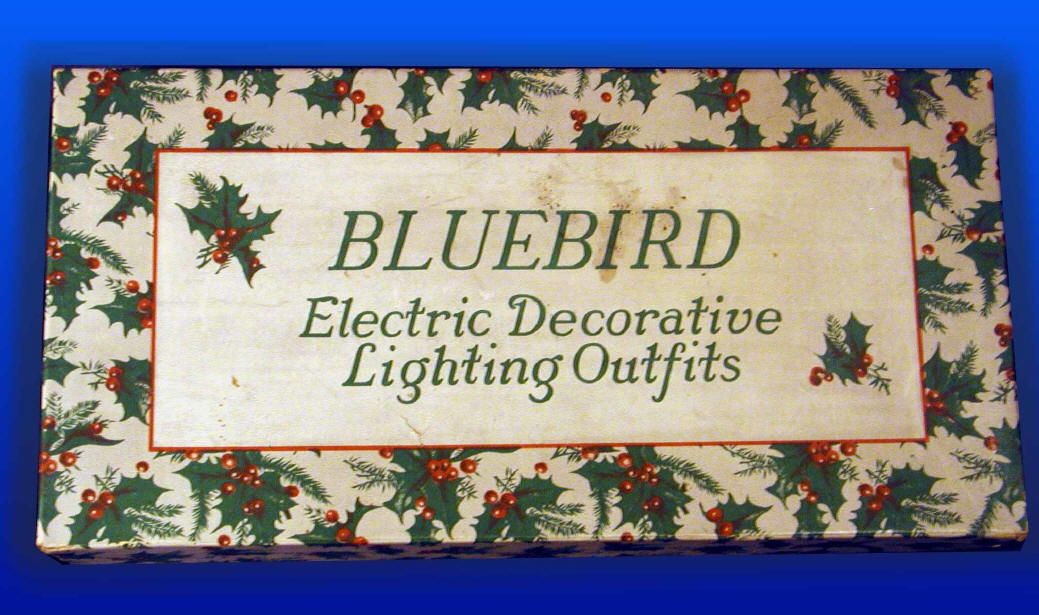 |
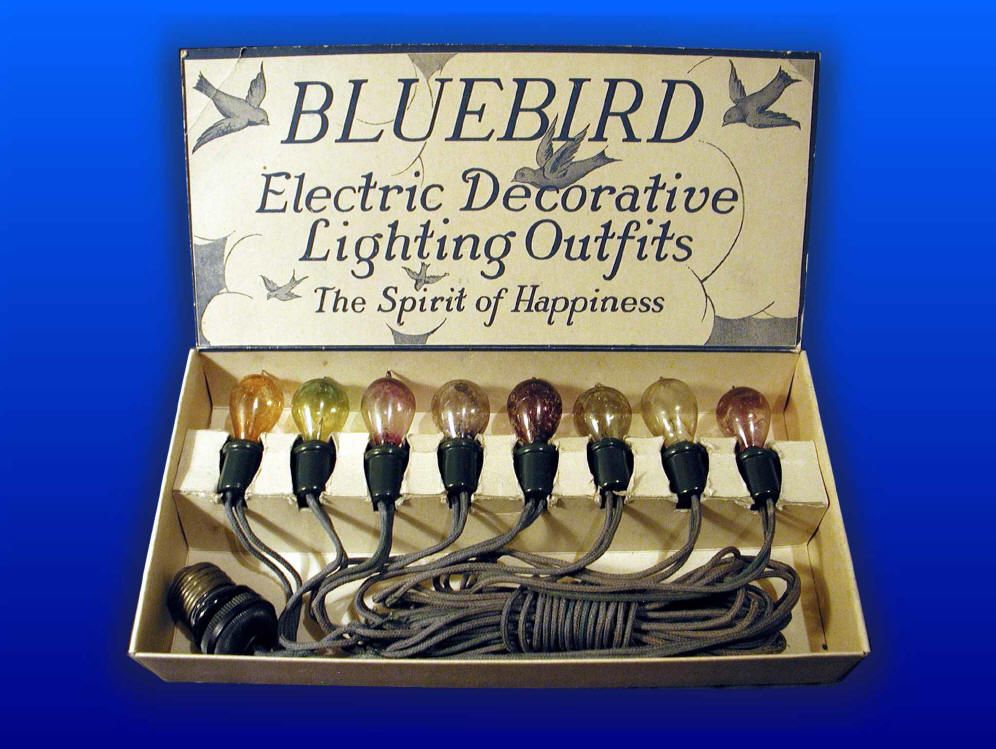 |
| ca
1922 |
Five
Seas Trading |
Here is an unusual outfit, courtesy of Rob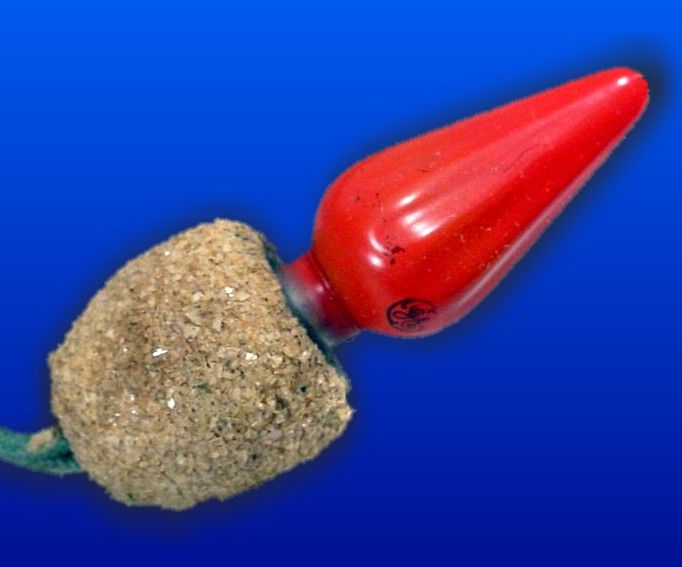 Runge. This is a rare outfit from Louis Szel's Five Seas Trading
Company. Szel was a pioneer in the early Christmas lighting
industry, concentrating mainly on importing lamps from Germany and
Austria. This is only one of three outfits this collector has seen,
and features unusual ground-glass covered composition sockets, an
effort to simulate snow. The outfit originally included German
twisted lamps, but now has later GE C-6 cone type lamps from the
1950s. Many of the sockets still retain their original soft copper
positioning strips, an aid to fastening the sockets on the tree
branches. Szel was later to become one of the founders of the famous
NOMA Electric Corporation.
Runge. This is a rare outfit from Louis Szel's Five Seas Trading
Company. Szel was a pioneer in the early Christmas lighting
industry, concentrating mainly on importing lamps from Germany and
Austria. This is only one of three outfits this collector has seen,
and features unusual ground-glass covered composition sockets, an
effort to simulate snow. The outfit originally included German
twisted lamps, but now has later GE C-6 cone type lamps from the
1950s. Many of the sockets still retain their original soft copper
positioning strips, an aid to fastening the sockets on the tree
branches. Szel was later to become one of the founders of the famous
NOMA Electric Corporation. |
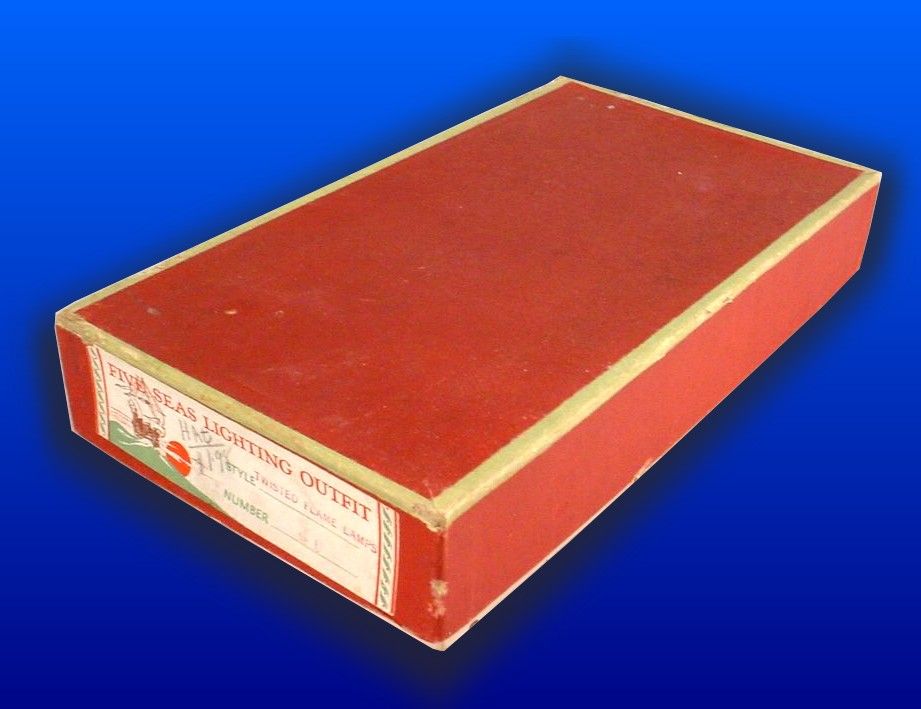 |
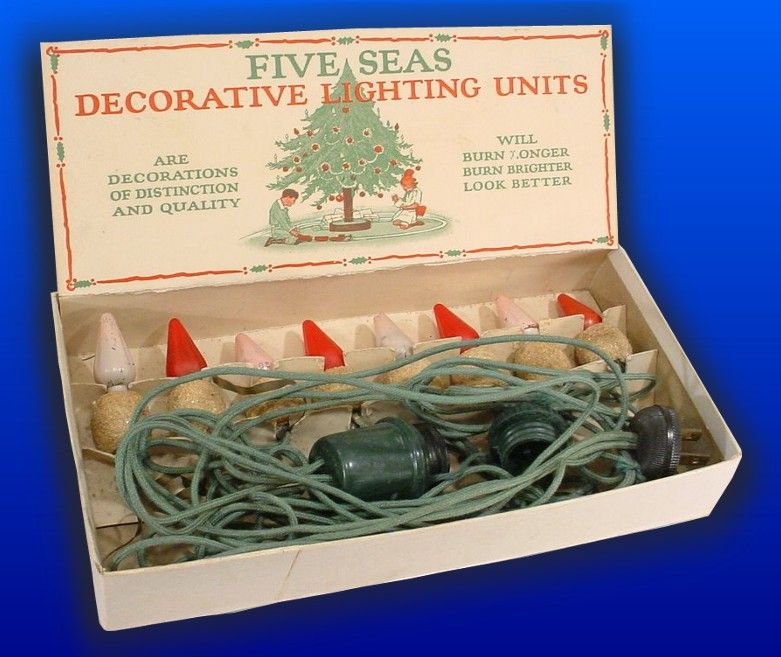 |
| ca
1922 |
Five
Seas Trading |
Another outfit from Five Seas, this
time with the proper carbon filament lamps installed. |
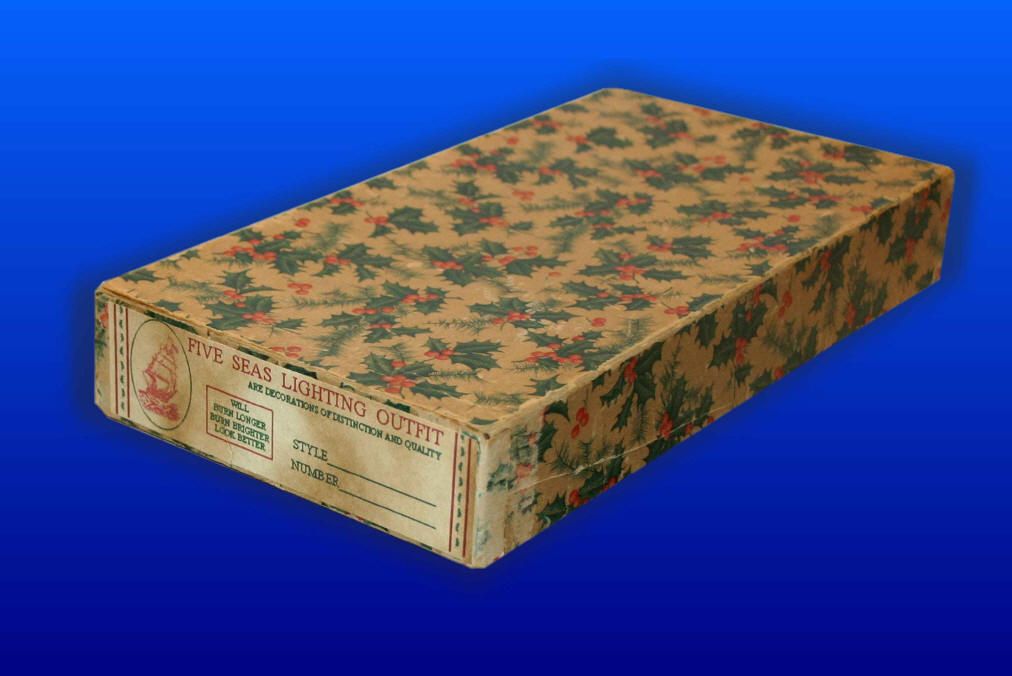 |
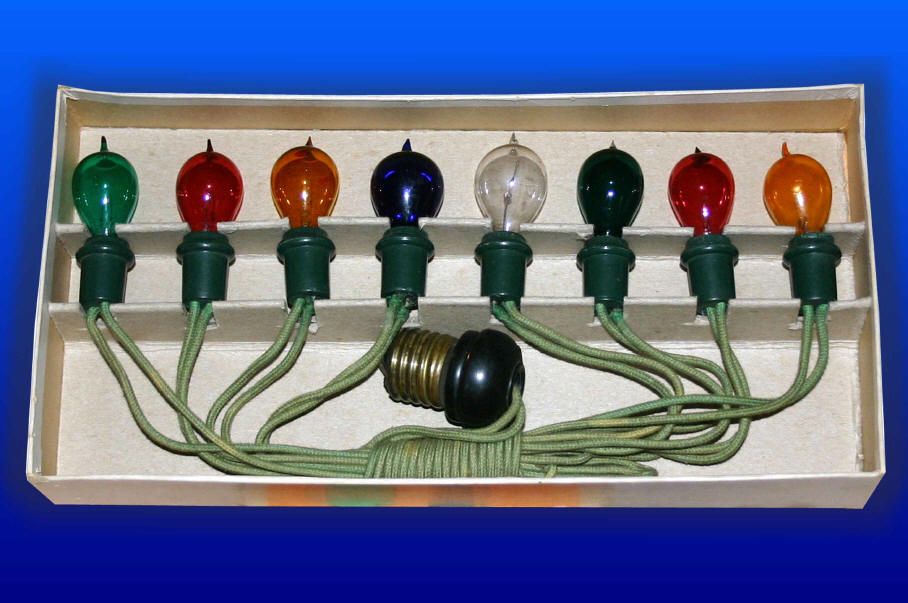 |
| ca
1922 |
USALITE |
An interesting set
that uses an early form of the Tatchon connector to facilitate the
addition of more lights. The lamps are tungsten filament examples
with an exhaust tip. This set is an example a late use of this style
of lamp. |
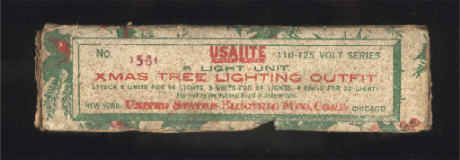 |
 |
| ca
1921 |
Triangle |
From the Triangle
Electro
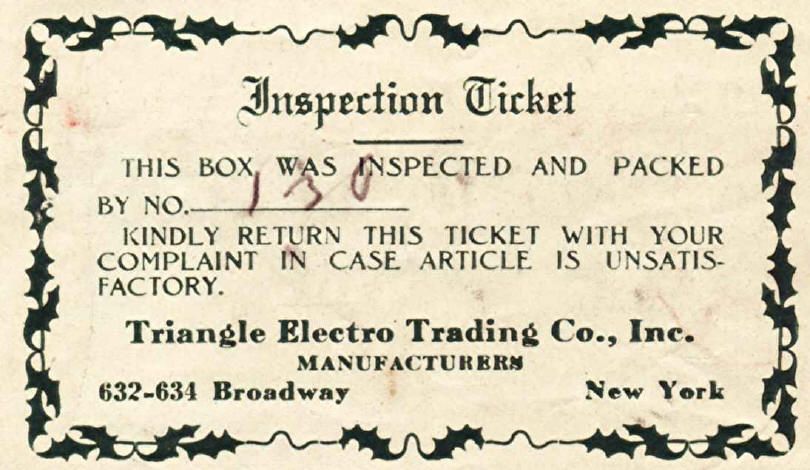 Trading
Company comes this outfit using the "new" smooth cone lamp style.
The box is rather plain, but the outfit does include an early
Inspector's Tag, promoting the quality of the outfit. Trading
Company comes this outfit using the "new" smooth cone lamp style.
The box is rather plain, but the outfit does include an early
Inspector's Tag, promoting the quality of the outfit. |
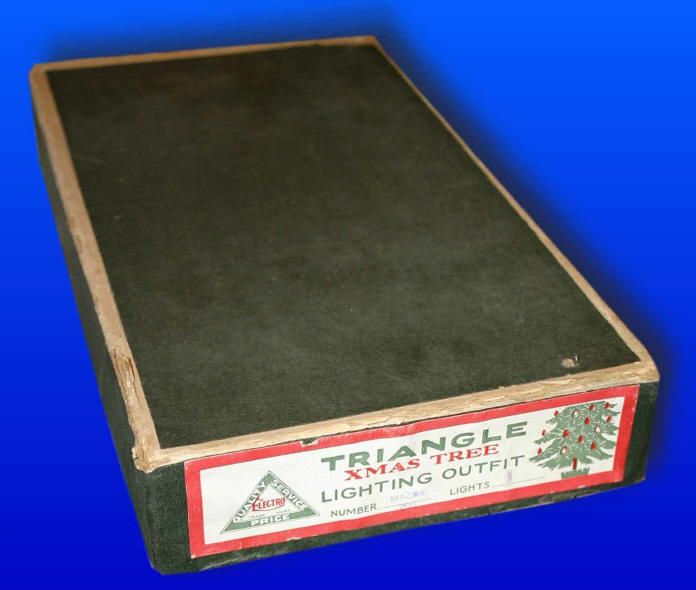 |
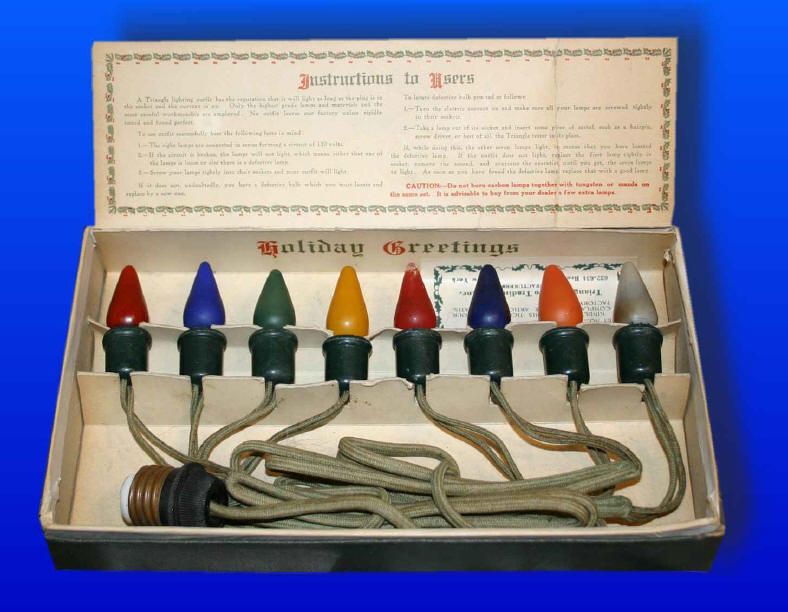 |
| ca
1924 |
Franco |
This outfit
contains 8 smooth cone carbon filament General Electric lamps.
Carbon filaments are exceedingly rare in American made smooth cone
lamps, and were offered only during the two or three years when GE
was sponsoring the transition from carbon filaments to tungsten
filaments in their Christmas lamps. (The Japanese manufactured
smooth cone carbons for a period of about eight years or so in the
1920s.) The outfit retains its original lamps, and even has
the cover cap for the end of cord add-on connector. Note that the
lamp colors are not duplicated within the string, and include an
uncommon shade of yellow as well as pink and purple. The box art
suggests other uses for this "Yere Round" set, which include Porch
Parties, the 4th of July, Lawn Parties Halloween and House Parties. |
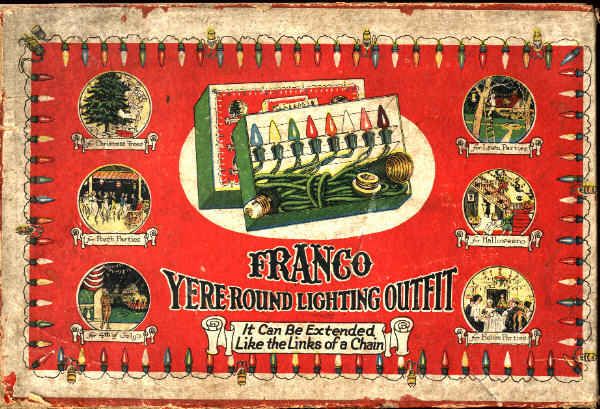 |
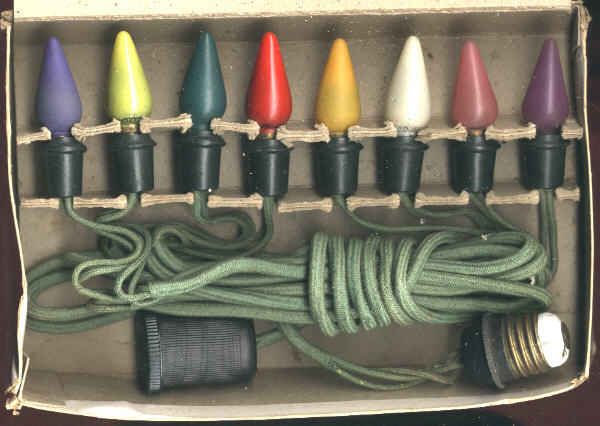 |
| ca
1923 |
Tree
Light |
Despite the fact
that the cover and inner flap of this very hard to find outfit
declare that the "Tree Light" brand is a trade mark, this collector
can find no evidence of the mark ever being registered. The cord is
unmarked as to maker, and the outfit contains eight smooth cone
carbon filament Japanese lamps. The outfit also includes an
extension socket. The ends of the box state that the set is American
made and the model number is 2X. The American made nomenclature
refers to the cord set only, not the lamps. |
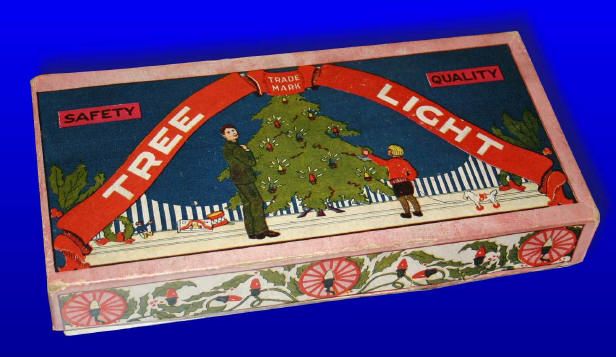 |
 |
| ca
1923 |
Yale |
This Yale Brand
outfit originally included eight German pine cone lamps and an
eight socket string with porcelain sockets. The set is now equipped
with Japanese pinecone lamps, most likely later replacements. This seems to be a late
use of ceramic socket material, as by the time this set was offered,
composition was in widespread use for festoon construction. This may also be an example of
the use of leftover stock, as the Yale Electric Corporation was a
later incarnation of the Interstate Novelty Company, an early and
prolific manufacturer of Christmas lighting outfits. |
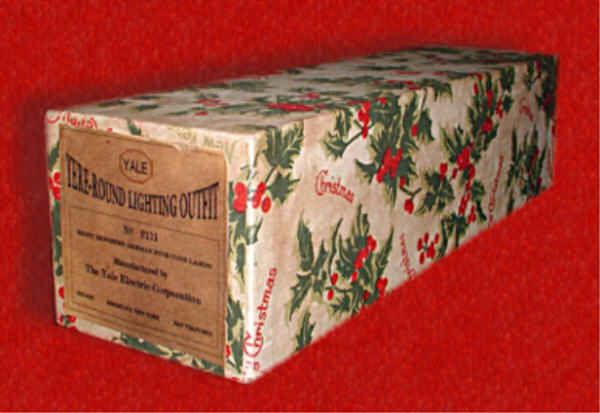 |
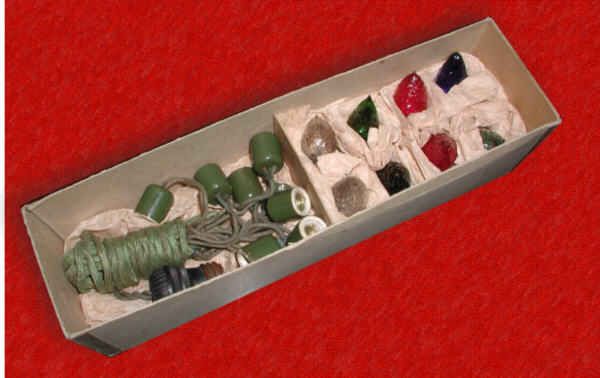 |
| ca
1923 |
Decorative Products Corporation, a division of Haupt, Incorporated |
Another late use of
materials, this outfit included an old fashioned junction box,
rather than a Tatchon-type connector. Also included were older
carbon filament lamps. |
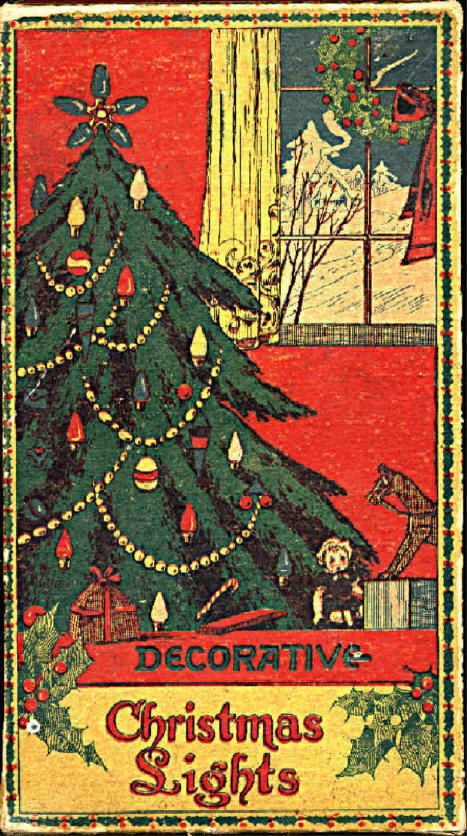 |
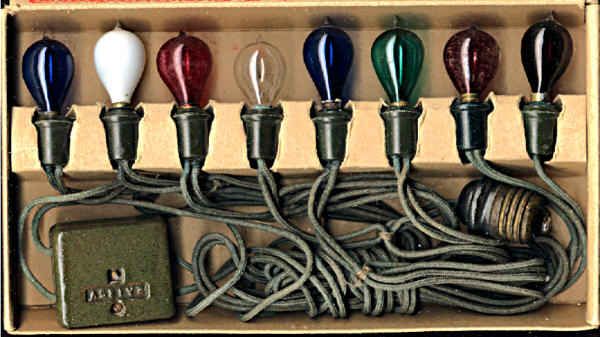 |
| ca
1923 |
Messervey's |
This outfit
demonstrates an early use of tungsten pine cone shaped lamps that
were hand painted. Messervey's also operated across the Canadian
border. The company mainly distributed figural lights, and was not
in business very long. The box art used on their containers was
quite "generic", and can be found on later boxes by other
manufacturers as well. |
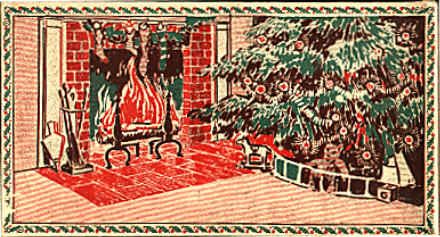 |
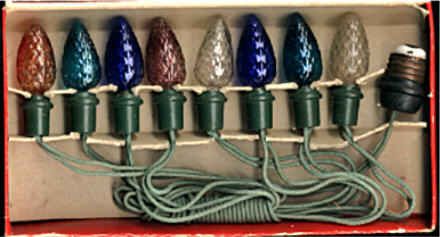 |
| ca
1923 |
Messervey's |
Here is a set of
figural lights from Messervey's of Buffalo, New York. These lamps
were the company's main product during their short period of
operation. The set includes a Santa Claus figure, a snowman, banana,
bulldog on a ball, a frog, a man smoking a pipe, a pear and a fish. |
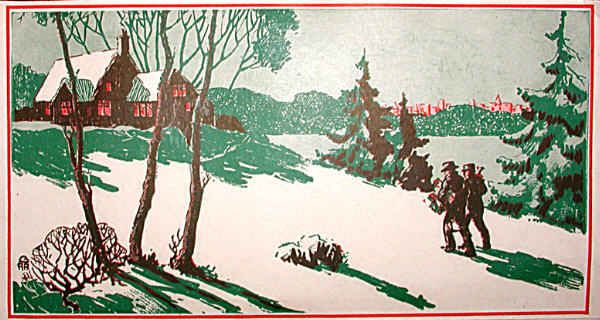 |
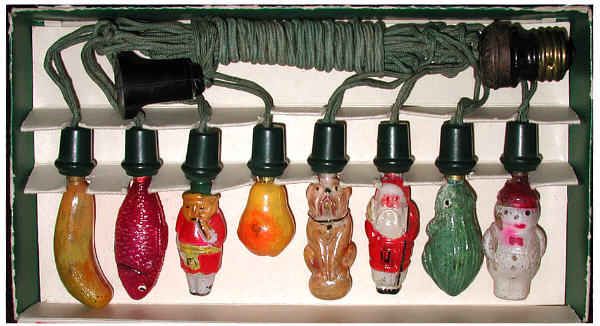 |
| ca
1923 |
Propp |
This set is
extremely rare. A very early "multiple wired" outfit, the set
contains 7 candelabra based 120 volt lamps with carbon filaments.
These lamps burn at a very high temperature, which makes them a bit
too dangerous to be effective Christmas lights. Despite the
advantage of independently burning lamps, sets of this type were not
big sellers. Multiple wired outfits did not become popular until
later, when in 1927 GE developed lamps that used coiled tungsten
filaments which burned at a far lower temperature. |
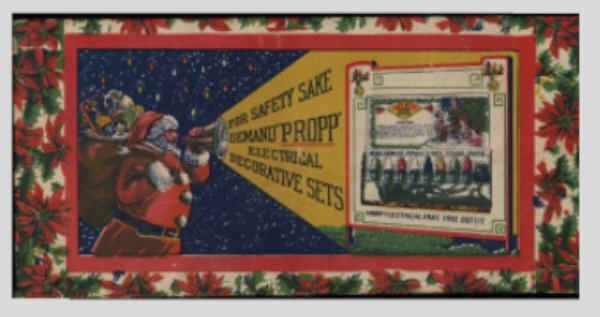 |
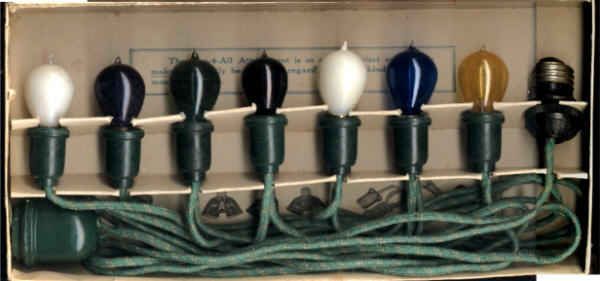 |
| ca
1923 |
Propp |
This
Propp set includes figural lamps from Japan, including (from left to
right): a monkey, fish, strawberry, pine cone, banana, frog, Santa,
and a dove. All these lamps have carbon filaments. The red sockets
on the festoon are quite rare and are not often seen. |
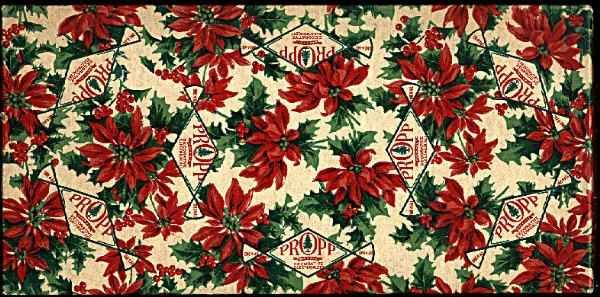 |
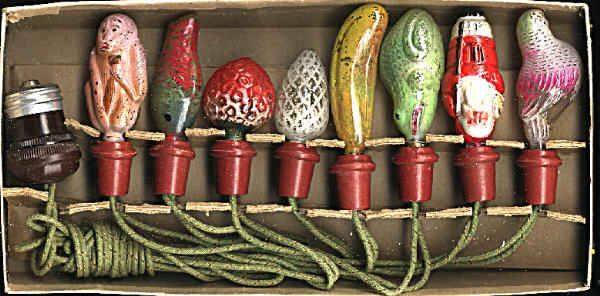 |
| ca
1924 |
Propp |
A
classic outfit by Propp, by far the most prolific early lighting
manufacturer of this time period before the formation of NOMA
Electric. Note the use of the Propp brand
One-4-All connector, complete with screw on cover. This is the
standard series wired miniature base outfit. Variations of this box
can be found with a green or yellow border around the cover art.
Propp offered many different lighting outfits in variations of this
classic box, some of which included less expensive cords or imported
lamps. |
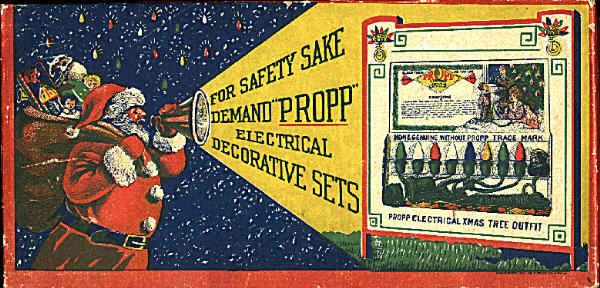 |
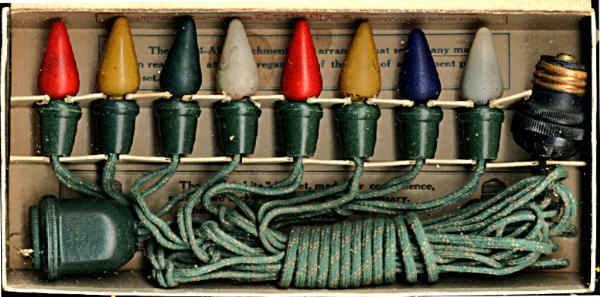 |
| ca
1924 |
USALITE |
This
is a late use of carbon lamps, probably to get rid of old stock. |
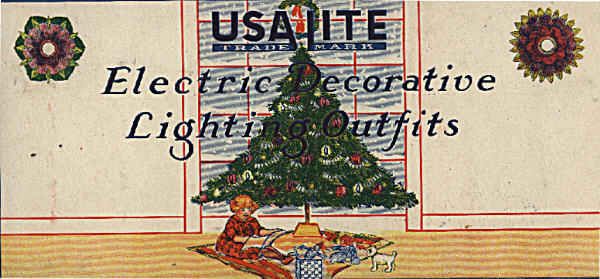 |
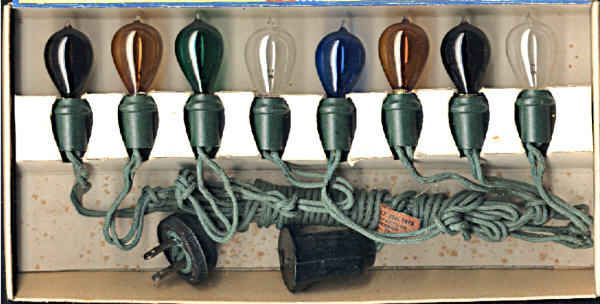 |
| ca
1924 |
Monowatt |
This
is an unusual light set that includes a set of eight cardboard
glitter-covered reflectors, used to increase the brilliancy of the
electric lights. |
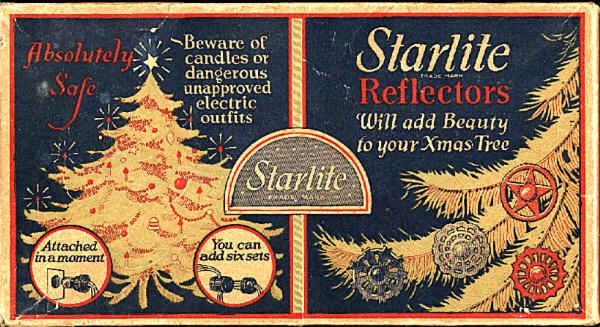 |
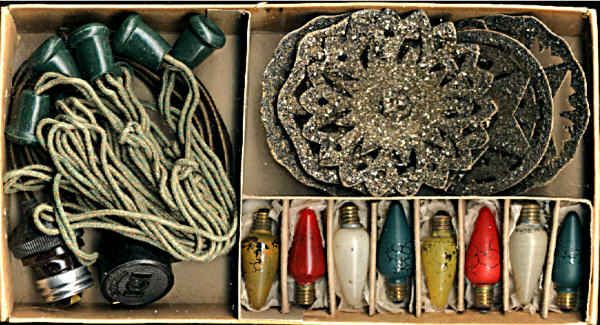 |
| ca
1924 |
Rainbow Electrical Mfg. Co. |
A very
rare find, this circa 1924 outfit from Rainbowlites is in absolutely
mint condition and has never even been taken out of the box. The
cord is still factory wrapped, and all of the smooth cone Mazda
light bulbs are original to the outfit. The set is in the best
condition of any on this site. The lights were found in a packed
shipping box, ready to mail, in the far back of a local department
store's attic. For some reason, it was never mailed, and has been
protected in the shipping box ever since. The festoon has the
unusual red sockets that are not commonly found. |
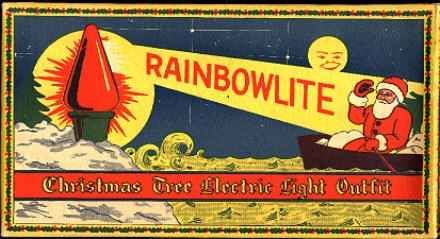 |
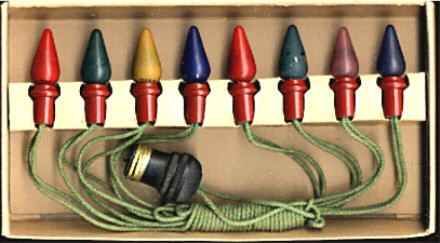 |
| ca
1924 |
Owl
Electric |
A
typical inexpensive set of series wired miniature base lights in a
colorful box. |
 |
 |
| ca
1924 |
Onyx
Electric |
This
outfit comes with pinecone lamps from Germany. |
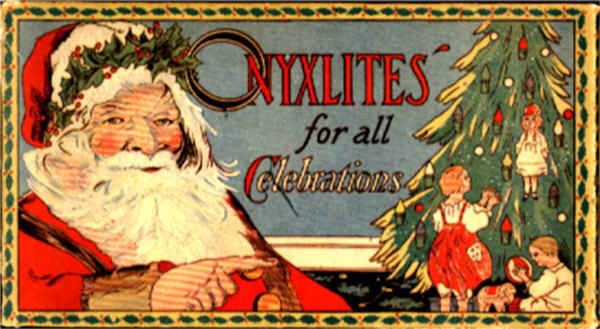 |
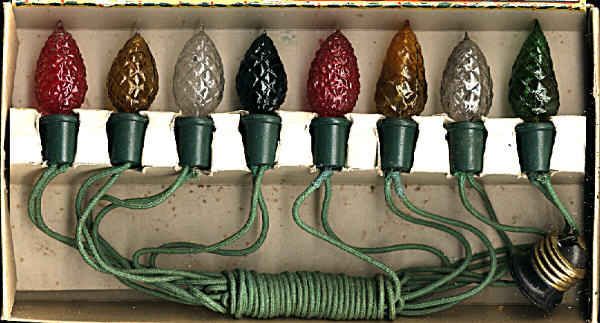 |
| ca
1924 |
Monowatt |
Circa 1924, this interesting outfit uses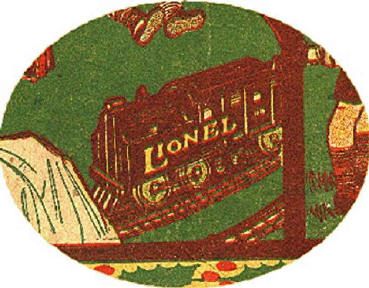 Japanese carbon filament lamps and has a picture of a Lionel train
on the box cover. It is unusual for one company to advertise the
product of another company on their own box, and this is the only
example of such a practice I've found on Christmas lights.
Japanese carbon filament lamps and has a picture of a Lionel train
on the box cover. It is unusual for one company to advertise the
product of another company on their own box, and this is the only
example of such a practice I've found on Christmas lights. |
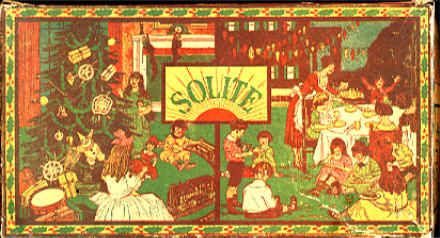 |
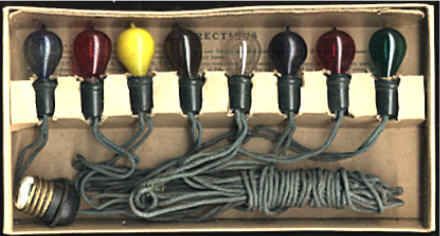 |
Welcome Page
TABLE OF CONTENTS
NEXT
|

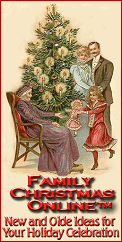
|



































